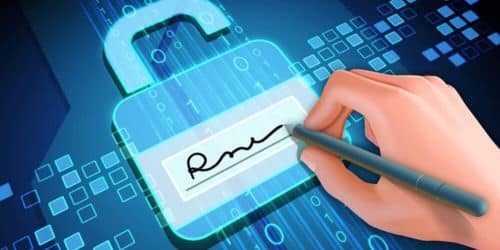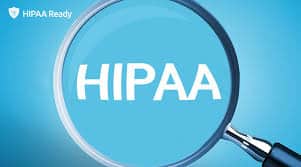A digital signature is exactly what it sounds like a modern substitute for signing documents with pen and paper.
It checks the validity and integrity of digital messages and documents using an innovative mathematical technique. It ensures that the contents of a message are not altered while in transit and aids in the prevention of impersonation and tampering in digital communications.
Digital signatures also include extra information such as the origin of the message, its status, and the signer’s consent.
What is a Digital Signature?
A digital signature is a type of electronic signature that functions similarly to an electronic “fingerprint.” It provides extra verification of individuals signing papers’ identity by delivering an encrypted authentication stamp and digital ID to authenticate information originating from them.
A digital signature securely associates a signer with a document in a recorded transaction through the use of a standard, approved format known as Public Key Infrastructure (PKI), which provides the highest levels of security and universal acceptability.
PKI is used to create a unique, tamper-evident “digital certificate” that associates a signer with a document and ensures that the electronic document is authentic. The digital certificate of the signer is utilized to create the signature, which is subsequently attached to the signed document.
The Function of Digital Signatures
Digital signatures are legally binding and have the same significance as traditional document signatures in many regions, including sections of North America, the European Union, and APAC.
They are also used for financial transactions, email service providers, and software distribution, all of which require the legitimacy and integrity of digital communications.
The data authenticity and integrity of a digital signature are ensured by industry-standard technology known as public key infrastructure.
How Do Digital Signatures Work?
A public key and a private key will be generated by a mathematical procedure by digital signature solution providers like Zoho Sign. When a signer digitally signs a document, a cryptographic hash of the document is generated.
That cryptographic hash is then encrypted with the sender’s private key, which is kept secure in an HSM box. It is then attached to the document and distributed together with the sender’s public key to the recipients.
With the sender’s public key certificate, the recipient can decrypt the encrypted hash. On the recipient’s end, a cryptographic hash is generated once more.
To verify its legitimacy, both cryptographic hashes are compared. If they match, the document has not been tampered with and is legitimate.
What Steps Should I Take to Create a Digital Signature?
Using an eSignature provider such as DocuSign, it is simple to create digital signatures. When you get a document for signing through email, you must authenticate according to the standards of the Certificate Authority and then “sign” the document by filling out a form online.
You should see ‘Start’ or ‘Sign’ instructions if you are prompted to sign from DocuSign eSignature. Follow the instructions to add your electronic signature if necessary, and then confirm your identity and follow the instructions to adopt your electronic signature.
Depending on the Certificate Authority, you may be required to provide additional information. There may also be constraints and limitations on who you submit documents to for signature and in what sequence you send them. The interface of DocuSign guides you through the process and guarantees that you meet all of these standards.
What is PKI (Public Key Infrastructure)?
Public Key Infrastructure (PKI) is a collection of circumstances that allows for the production of digital signatures, as well as the management of digital certificates and public and private keys.
Each digital signature transaction involving PKI includes a pair of keys: a private key and a public key. The private key, as the name implies, is not shared and is only used by the signer to electronically sign documents. The public key is freely available and is used by anyone who needs to validate the electronic signature of the signer.
Additional requirements are enforced by PKI, such as the Certificate Authority (CA), a digital certificate, end-user enrolment software, and tools for managing, renewing, and revoking keys and certificates.
What is Certificate Authority (CA)?
Public and private keys are used in digital signatures. To maintain safety and deter forgery or malicious usage, the keys must be safeguarded. When you send or sign a document, you need to know that the documents and keys were made securely and using valid keys.
A certificate authority is a sort of Trust Service Provider, a third-party organization that has been widely acknowledged as trustworthy for maintaining key security and can offer the required digital certificates. The entity delivering the document and the entity signing it must both agree to use a specific CA.
When signers use the DocuSign Express Digital Signature, DocuSign becomes a CA. That is, if you use DocuSign as the Certificate Authority, you can deliver a document with a digital signature.
Alternatively, you can use the DocuSign Signature Appliance to securely construct your own CA while still gaining access to the full capabilities of DocuSign cloud services for transaction management. Other well-known CAs are used by some organizations or regions, and the DocuSign platform supports them as well.
OpenTrust, which is extensively used in European Union countries, and SAFE-BioPharma, an identification credential that life science organizations may choose to utilize, are two examples.
What is the Purpose of Using a Digital Signature?
Electronic signatures offer numerous advantages, and digital signatures are one sort of electronic signature. Digital signatures are more secure since they encrypt signatures and verify the signer’s identity. Digital signatures using the PKI technique use an international, well-understood, standards-based technology that also helps prevent forgery or alterations to the document after signing.
Many industries and geographical regions have established eSignature standards for business documents that are based on digital signature technology and certain certified CAs. Following these local standards based on PKI technology and collaborating with a trusted certificate authority can secure an e-signature solution’s enforceability and acceptance.
Are eSignatures, which use Digital Signature Technology, Legally Binding?
Yes. In 1999, the European Union established the EU Directive on Electronic Signatures, and in 2000, the United States passed the Electronic Signatures in Global and National Commerce Act (ESIGN). Both measures rendered electronically signed contracts and documents, like paper-based contracts, legally binding. The legality of electronic signatures has been upheld numerous times since then.
Most countries have now enacted legislation and regulations modeled after the United States or the European Union, with many areas preferring the European Union model of locally managed, digital signature technology-based eSignatures. Furthermore, by utilizing digital signature technology, several organizations have enhanced compliance with the standards created by their industries (e.g., FDA 21 CFR Part 11 in the Life Sciences industry).
These national and industry-specific regulations are constantly changing. The impact of electronic signature law in the UK remains the same post-Brexit, as the UK passed the European Union (Withdrawal) Act 2018 to provide legal certainty and continuity of EU laws under UK laws, including eIDAS, which governs electronic transactions in the European Single Market and electronic signatures.
What are the Advantages of Using Digital Signatures?
#1. Trustworthy and compliant.
Digital signatures backed by third-party digital certificates enable you to comply with rules all over the world.
#2. Protected.
Your digital signature and the signed PDF electronic document are encrypted and sealed with a tamper-evident seal.
#3. You are unique.
When you digitally sign, use your unique digital identity to easily check your credentials and authorize your signature.
#4. Validation is simple.
Renewal is required for digital signature validation because the signed document and digital signature are designed to be revalidated for at least ten years.
Assurances of Digital Signatures
The concepts and descriptions below demonstrate the assurances afforded by digital signatures.
- Authenticity: The signer’s identity has been confirmed.
- Integrity: Since it was digitally signed, the content has not been altered or tampered with.
- Non-repudiation: The origin of the signed content is proven to all parties. The act of a signer denying any relationship with the signed material is referred to as repudiation.
- Notarization: Under some conditions, signatures in Microsoft Word, Microsoft Excel, or Microsoft PowerPoint files that have been time-stamped by a secure time-stamp server have the legitimacy of a notarization.
To provide these assurances, the content author must digitally sign the content with a signature that meets the following requirements:
- The digital signature is correct.
- The digital signature certificate is current (it has not expired).
- The publisher is the person or entity who signs the document.
What is the Difference Between a Digital and an Electronic Signature?
Different types of electronic signatures are included in the wide category of electronic signatures (eSignatures). A digital signature is included in this category. Through digital certificates, digital signatures provide a higher level of identity assurance. You can sign papers and validate the signer using digital signatures and other signature systems. However, there are distinctions between digital signatures and other types of eSignatures in terms of intent, technological implementation, geographical application, and legal and cultural acceptance.
There are three types of digital signatures: basic electronic signatures (SES), advanced electronic signatures (AES), and qualified electronic signatures (QES).
The usage of digital signature technology for eSignatures differs greatly between nations that have open, technology-neutral eSignature regulations, such as the US, UK, Canada, and Australia, and those that have tiered eSignature models. Many nations in the European Union, South America, and Asia choose tiered eSignature models based on locally specified norms based on digital signature technology. Furthermore, several businesses adopt industry-specific standards based on digital signature technology.
What is a Digital Identity?
A digital identification (or digital ID), similar to a passport in electronic form, gives convincing evidence that you are who you say you are when e-signing a document. Each digital ID is backed by a digital certificate provided by a trusted third party, such as a bank or government after your identity has been thoroughly verified.
Using a digital ID to verify your identity and a digital signature during the document signing process ensures that you consented to the terms mentioned and authorized your signature on a specific document.
What is a Digital Certificate?
A digital certificate is a digital document that a Certificate Authority (CA) issues. It contains the public key for a digital signature as well as the identification connected with the key, such as an organization’s name. The certificate validates that the public key belongs to the specified organization. The CA serves as a guarantor. Digital certificates must be issued by a trusted authority and have a limited validity period. They are necessary to create a digital signature.
What is a Cloud Signature?
A cloud signature is a digital signature in which the signer’s digital certificate is administered in the cloud by a trust service provider (TSP). The Cloud Signature Consortium (CSC) produced a global open standard for cloud signatures. Unlike a standard digital signature that is applied with a physical smart card or USB token, a cloud signature allows you to apply verified digital signatures instantly from a mobile device or a Web browser.
What Is an Electronic Seal?
A legal entity, such as a business or organization, will employ an electronic seal or e-seal to confirm the origin, legitimacy, and integrity of documents. Electronic seals can give strong legal evidence that a document was not altered and came from the entity represented by the digital sealing certificate.
Related Articles
- SIGNATURE APP: Top 10 Apps, Gmail, iPhone & Free Apps
- PROFESSIONAL EMAIL: Meaning, How to write it & Crucial Tips to know
- CONTRACT MANAGEMENT SYSTEMS: 2023 Top Best Software
- How To Sign A Document Electronically: A Step-By-Step Guide






